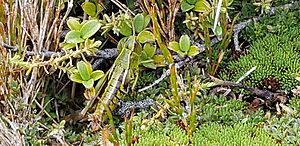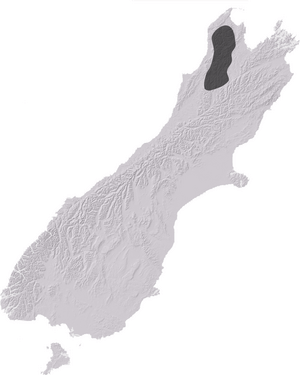Alpinacris crassicauda facts for kids
Quick facts for kids Alpinacris crassicauda |
|
|---|---|
 |
|
| Scientific classification | |
| Kingdom: | |
| Phylum: | |
| Class: | |
| Order: | |
| Family: | |
| Genus: |
Alpinacris
|
| Species: |
A. crassicauda
|
| Binomial name | |
| Alpinacris crassicauda Bigelow, 1967
|
|
 |
|
| The distribution of A. crassicauda in New Zealand | |
The Alpinacris crassicauda is a special type of grasshopper. It lives only in the West Coast Region and Tasman District of New Zealand. This type of grasshopper is found nowhere else in the world! It's only on the South Island of New Zealand.
A scientist named Robert Sidney Bigelow first described this grasshopper in 1967. He found the first one near Lead Hills and Boulder Lake. The original grasshopper specimens are kept at the Canterbury Museum, Christchurch.
Like other grasshoppers in the mountains of New Zealand, A. crassicauda has a long life cycle. It takes 2 or 3 years for them to grow from an egg to an adult. Their eggs need to survive the winter before they can hatch. Young grasshoppers, called hoppers, can be seen all year round. Adult grasshoppers are usually found during the New Zealand summer, from December to April. Adult A. crassicauda grasshoppers do not survive the winter.
Where It Lives and What It Likes
The Alpinacris crassicauda grasshopper is only found in the West Coast Region and Tasman District of New Zealand. You can find them as far south as the Rahu River and as far north as the Thousand Acres Plateau.
These grasshoppers love to live in alpine tussock grasslands. These are grassy areas high up in the mountains. They usually live between 1,200 and 1,500 meters (about 3,900 to 4,900 feet) above sea level. Sometimes, they can be found a bit lower, around 1,020 meters (about 3,300 feet), like on the Thousand Acres Plateau.
What It Looks Like
The Alpinacris crassicauda grasshopper has very small wings. These wings are only about 2 to 4 millimeters long. This means they cannot fly, just like most other grasshoppers in New Zealand.
Male A. crassicauda grasshoppers are usually between 18 and 22 millimeters long. Female grasshoppers are bigger, measuring about 25 to 35 millimeters long.
How We Know About This Species
- The first detailed description of this grasshopper was in a book by R.S. Bigelow in 1967. The book was called "The Grasshoppers of New Zealand, Their Taxonomy and Distribution."
- The first grasshopper specimen was found at Lead Hills, near Boulder Lake in the Tasman District.
- This first male specimen was collected on October 27, 1963, by P. M. and M. Johns. The original specimens are now kept at the Canterbury Museum in Christchurch.

